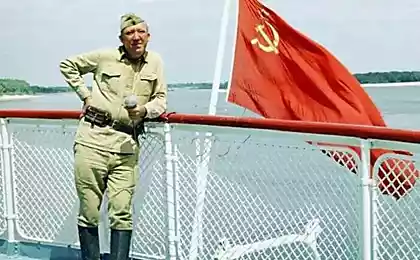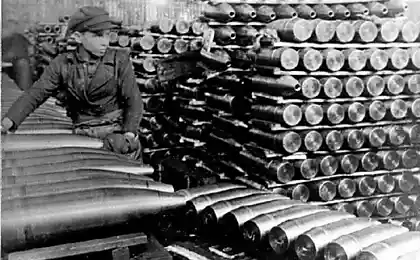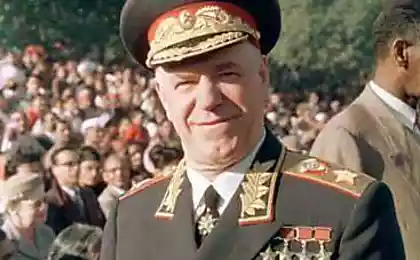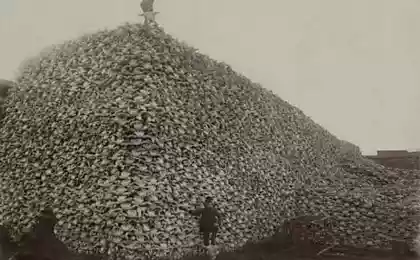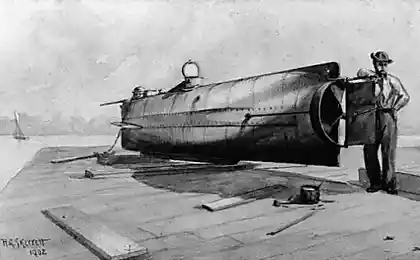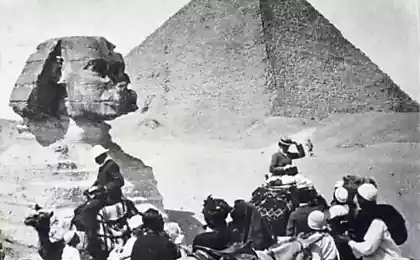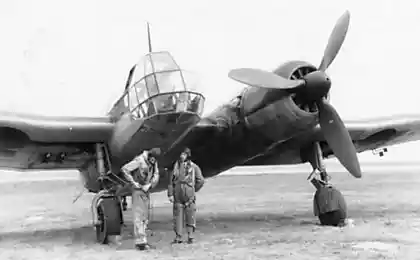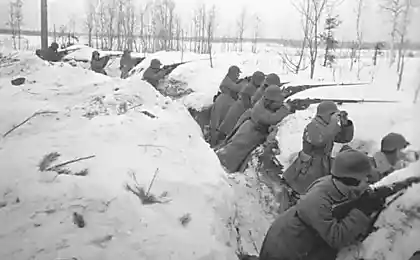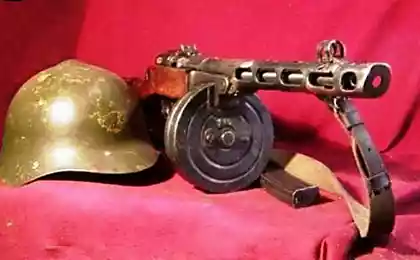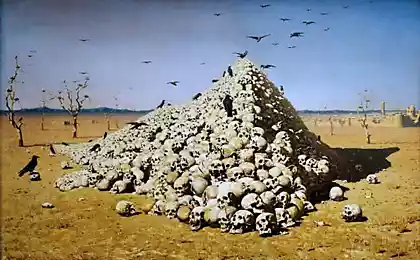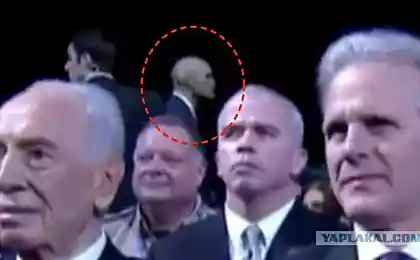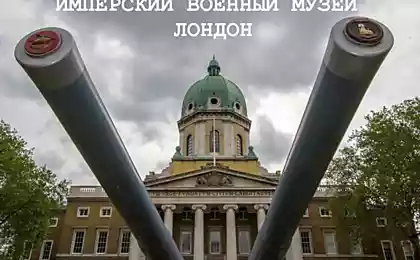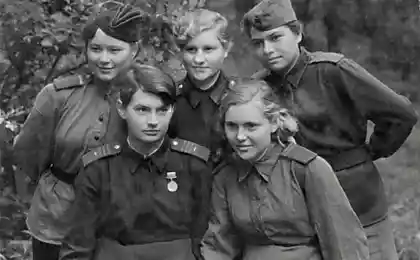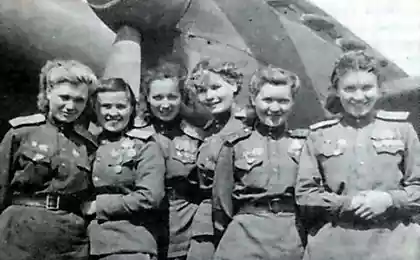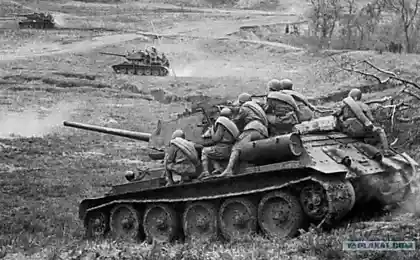2784
World War II - after the war (45 photos)
When in the late 1930s, World War II began, the Earth's population was approximately 2 billion people. Less than ten years of war between the Allied forces and the countries of the fascist bloc in the general ease killed 80 million people, or 4% of the world's population. Over time, the allied forces have become invaders who occupied Germany, Japan and most of the territory under their control. In Europe and Asia to hear cases of war crimes, and then followed by numerous executions and imprisonments. Millions of Germans and Japanese were forcibly evicted from the regions that they considered their home.
Occupation by Allied troops and some UN decisions have led to certain consequences in the future, including the division of Germany into East and West, as well as the formation of North and South Korea and the beginning of the Korean War in 1950. Thanks to the United Nations Partition Plan for Palestine in 1948, Israel declared itself an independent state, but broke the Arab-Israeli conflict. All ongoing tensions between the West and the Soviet bloc resulted in a "cold war". In connection with the development and proliferation of nuclear weapons in grave danger of World War III if the parties are unable to find a common language.
World War II was the most significant event of the 20th century, and its effects continue to influence the modern world, even after 65 years.
1. General Wehrmacht Anton Dostler tied to a pole before his execution by firing squad in Aversa, Italy, December 1, 1945. The general who commanded the 75th Army Corps, was sentenced to death by a military commission USA in Rome for the shooting of 15 unarmed American prisoners of war in La Spezia, Italy, March 26, 1944. (AP Photo) #.
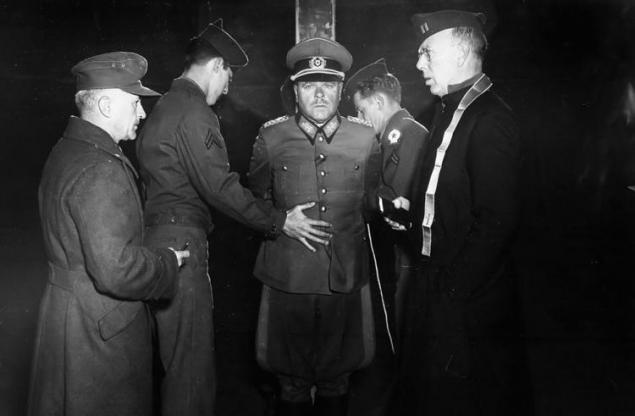
2. The Soviet soldiers are with lowered Nazi flags during a parade in honor of Victory Day on Red Square in Moscow, June 24, 1945. (Yevgeny Khaldei / Waralbum.ru) #.
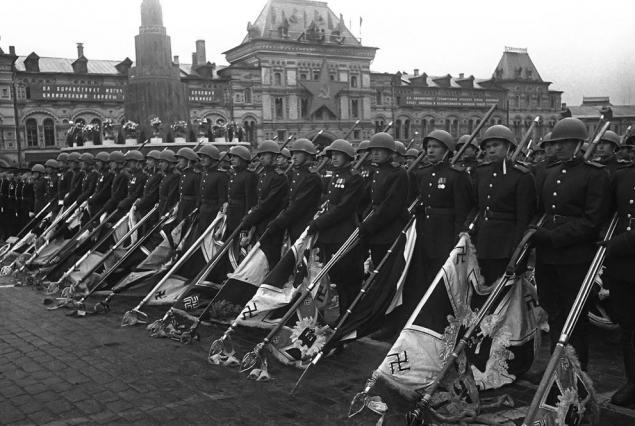
3. Exhausted Allied POWs collect things after liberation from Japanese captivity near Yokohama, Japan, September 11, 1945. (AP Photo) #.

4. Return of Soviet soldiers winners at the railway station in Moscow, 1945. (Arkady Shaikhet / Waralbum.ru) #.
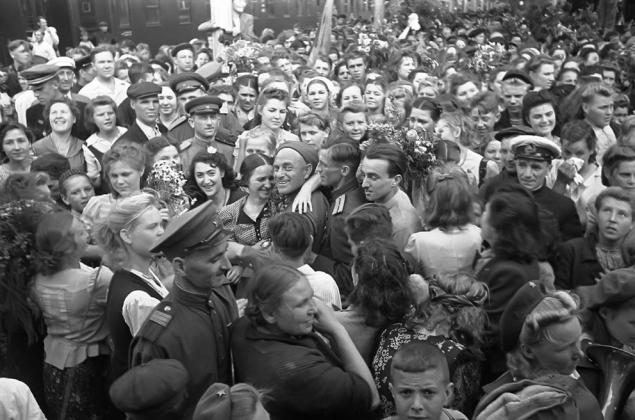
5. Aerial view of Hiroshima, Japan, a year after the explosion of the atomic bomb, July 20, 1946. The city is slowly recovering due to lack of materials and equipment. (AP Photo / Charles P. Gorry) #.
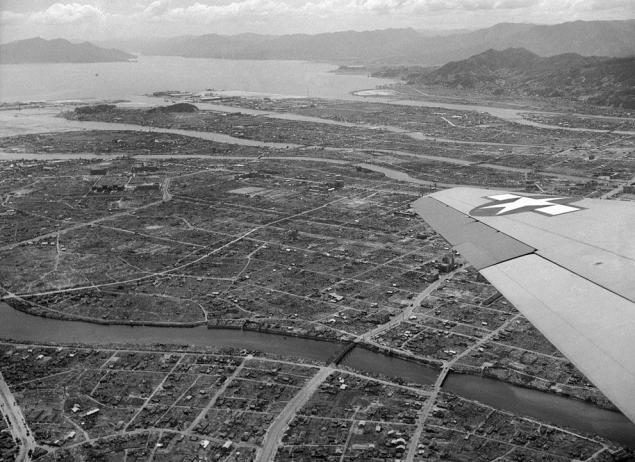
6. Japanese sits near the charred ruins on the spot where once stood his home in Yokohama, Japan. (NARA) #.
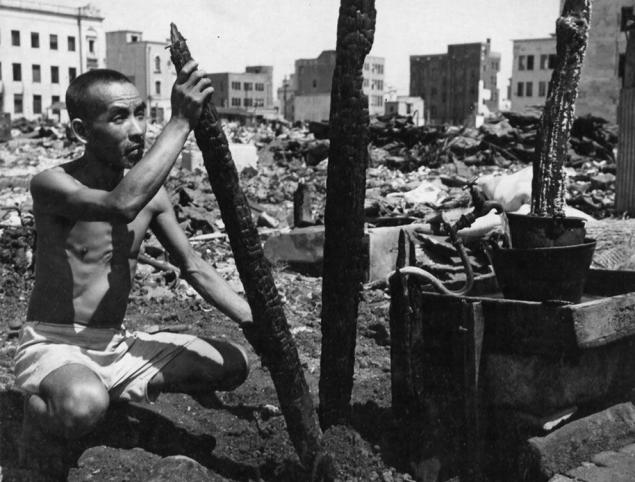
7. Red Army Photographer Eugene Chaldea (center) in Berlin with Soviet troops near the Brandenburg Gate, in May 1945. (Waralbum.ru) #.

8. The fighter-bomber Ripablik P-47 "Thunderbolt" 12th Air Army US flies at low altitude over the refuge of Hitler in Berchtesgaden, Austria, May 26, 1945. On the ground around the damaged structure can be seen large and small craters from shells. (AP Photo) #.
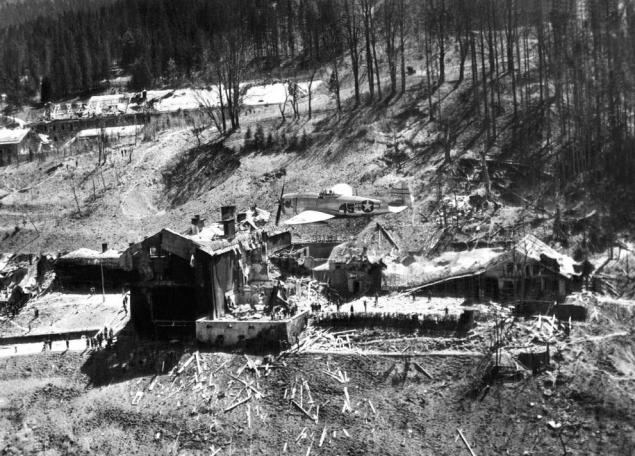
9. Hermann Goering, the former commander of the Luftwaffe and the chairman of the Reichstag. The photograph was taken by the Office Central Registry of War Criminals and Security Suspects in Paris, France, November 5, 1945. May 9, 1945, Goering surrendered to US soldiers in Bavaria and was sent to Nuremberg, where stand trial on charges of war crimes. (AP Photo) #.

10. The interior of the courtroom, where in 1946 the Nuremberg Trials held hearings on the case of serious war crimes over 24 heads of government and civic leaders of Nazi Germany. Hermann Goering, the former commander of the Luftwaffe, sitting on a bench to testify (center right) in a gray jacket, wearing headphones and sunglasses. Next to him sat Rudolf Hess, the former Deputy Fuhrer of the party, Joachim von Ribbentrop, the former Foreign Minister of Nazi Germany, Wilhelm Keitel, former Chief of Staff of the Supreme Command of the armed forces of Germany and the SS-Obergruppenführer Ernst Kaltenbrunner. Goering, Ribbentrop, Keitel and Kaltenbrunner were sentenced to death by firing squad. Goering committed suicide the night before the execution. Hess was sentenced to life imprisonment, which is served in Spandau Prison in Berlin until his death in 1987. (AP Photo / STF) #.
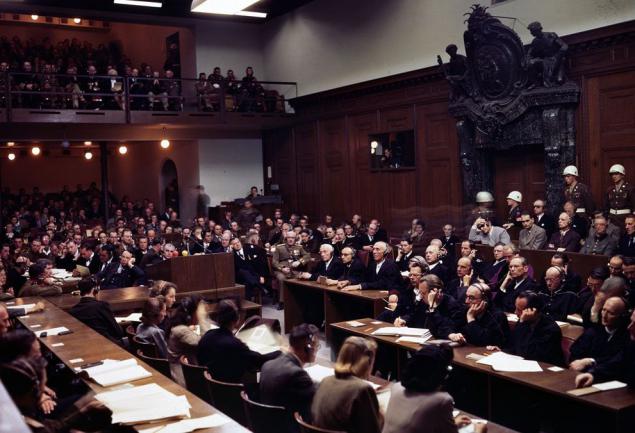
11. Many of the captured German new and experimental aircraft were exhibited in London on the eve of Thanksgiving Day, September 14, 1945. Among the aircraft had been exhibited and jets. Photo: side view of a fighter Heinkel He-162 «Volksjager», which was equipped with a turbojet engine mounted above the fuselage, in Hyde Park in London. (AP Photo) #.
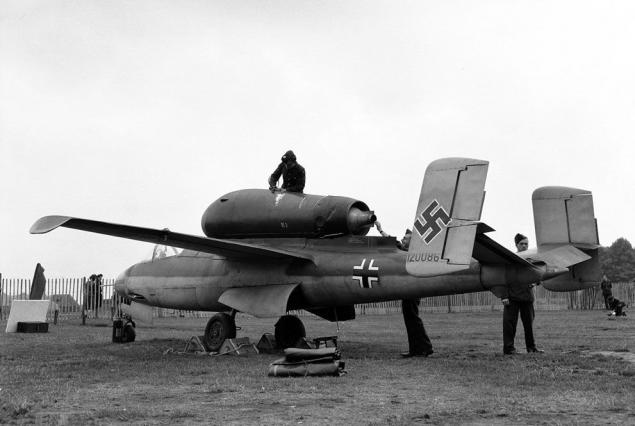
12. German POWs leveled the ground on the first American cemetery in the commune of Saint-Laurent-sur-Mer, France, close to the beach "Omaha", a year after the landing in Normandy, 28 May 1945. (AP Photo / Peter J. Carroll) #.
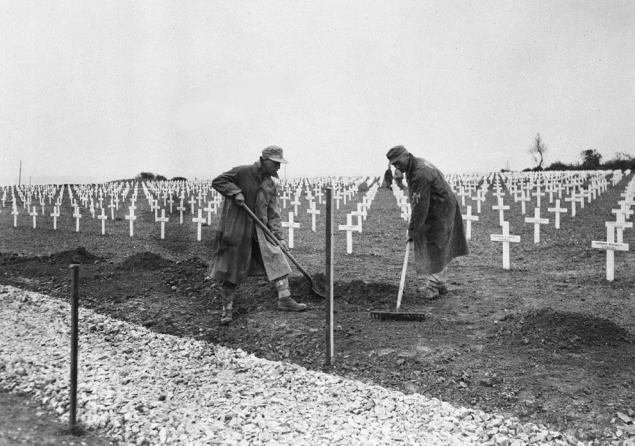
13. The Sudeten Germans go to the train station in the city of Liberec, the former Czechoslovakia to leave for Germany, July 1946. After the war, millions of German citizens and ethnic Germans were expelled from the territories annexed by Germany and the German states, which departed Poland and the Soviet Union. The number of deported Germans between 12 and 14 million. According to some estimates, during the resettlement died from 500,000 to 2 million Germans. (AP Photo / CTK) #.
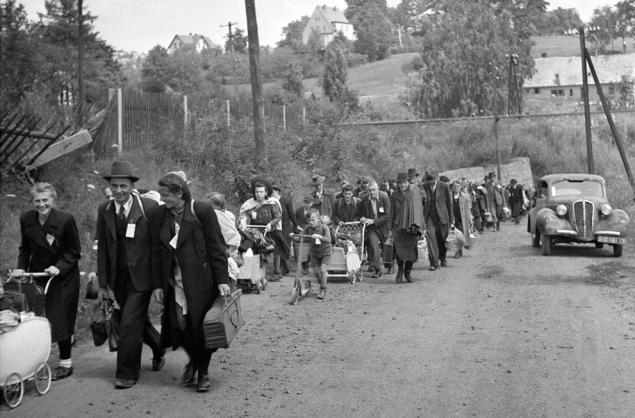
14. Body Jinpe Teravama, surviving after the first in the history of the atomic bombing, scars after healing of burns, Hiroshima, June 1947. (AP Photo) #.
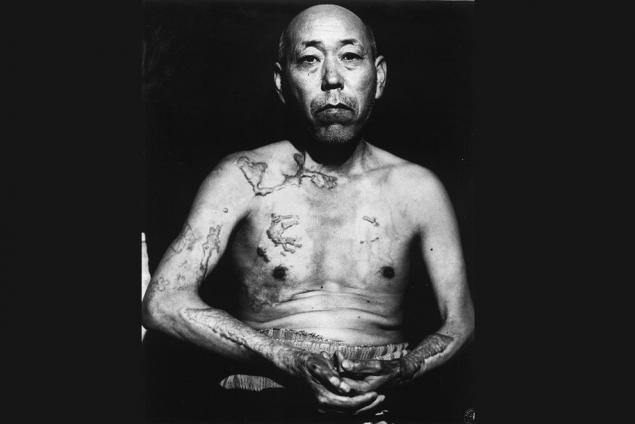
15. Broken buses made up for an acute shortage of housing in the capital of Japan, October 2, 1946. Homeless Japanese buses towed to a vacant lot and settle in their homes for their families. (AP Photo / Charles Gorry) #.
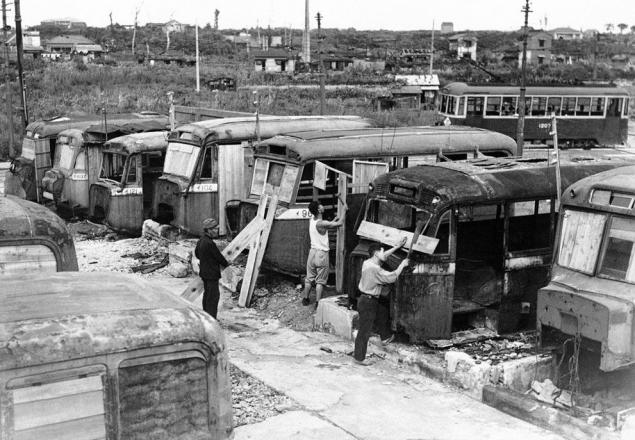
16. An American soldier hugs Japanese girl admiring Hibiya Park near the Imperial Palace Tokyo, January 21, 1946. (AP Photo / Charles Gorry) #.
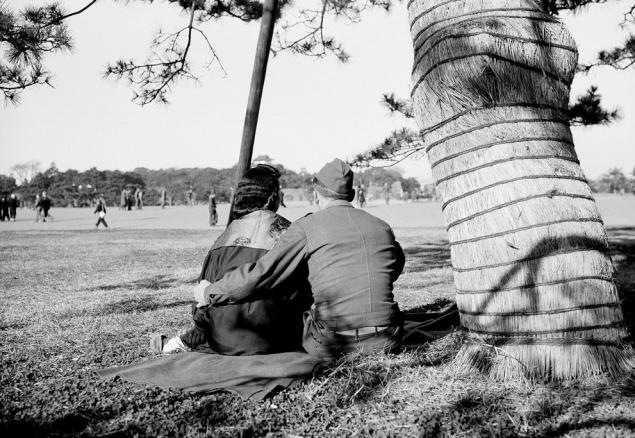
17. Aerial view of the destroyed by bombing area of London near St Paul's Cathedral, in April 1945. (AP Photo) #.

18. General Charles de Gaulle (center) shakes hands with children in Lorient, France, two months after the surrender of Germany, in July 1945. During the Second World War in Lorient housed a German submarine base. Between 14 and 17 February 1943 at Lorient were dropped 500 high-explosive and over 60,000 incendiary bombs. The city was destroyed by 90%. (AFP / Getty Images) #.
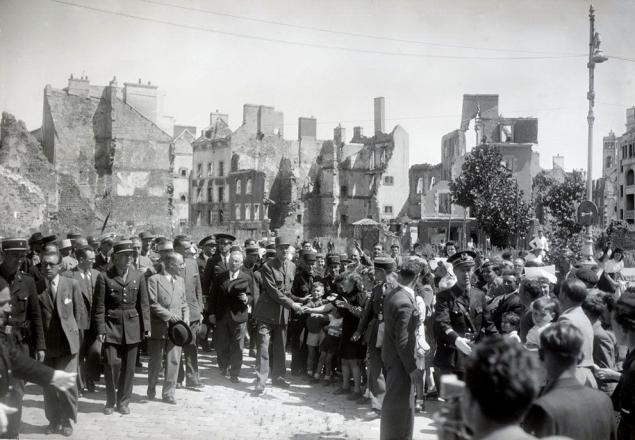
19. The transport ship «General WP Richardson »with combatants on board is in the dock in New York, June 7, 1945. Many of these soldiers took part in the African campaign battles in Salerno, Anzio, Cassino and winter battles in the mountains of Italy. (AP Photo / Tony Camerano) #.
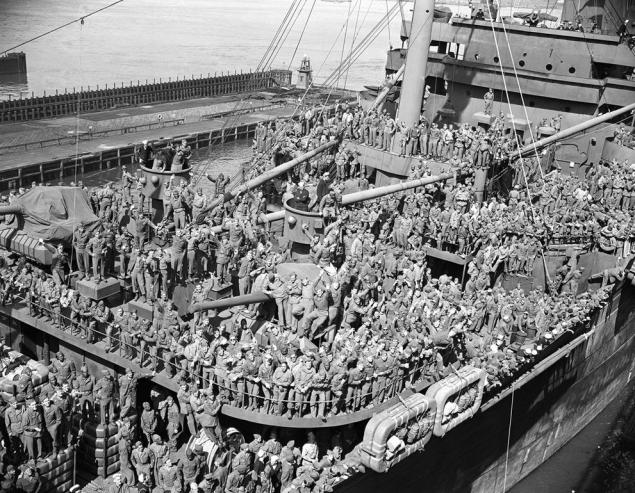
20. On the aerial photographs can be seen from the archive section Levitauna, New York, shortly after the completion of the post-war settlement on farmland in 1948. Levitaun was one of the first towns built for soldiers returning from World War II. He became a symbol of post-war suburban communities in the United States. (AP Photo / Levittown Public Library, File) #.
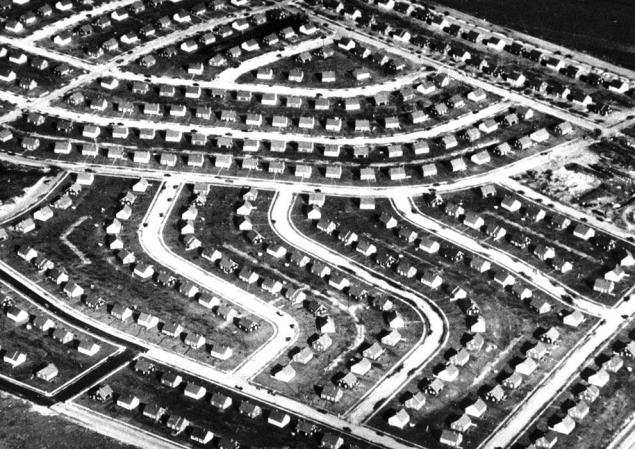
21. This TV, which costs $ 100, was the first receiver, retailing at an affordable price. Television was invented before the start of the Second World War, but military action prevented the mass production of televisions. (AP Photo / Ed Ford) #.
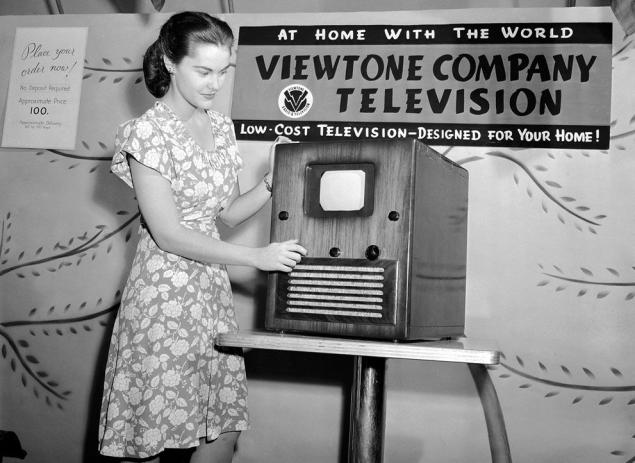
22. US soldier inspects a gold statuette of a personal cache of Hermann Goering found the 7th US Army in a cave near Schonau am Konigssee, Germany, May 25, 1945. In the secret cave also found stolen priceless paintings from all over Europe. (AP Photo / Jim Pringle) #.
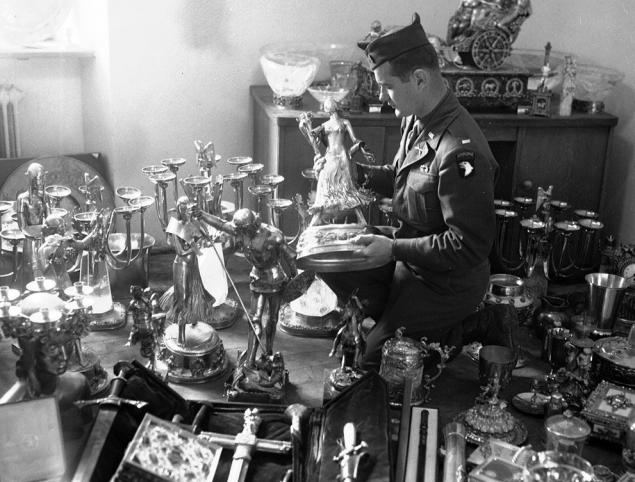
23. Some churches in Europe have been razed to the ground, while others remained standing among the ruins. Photo: menhengladbahskoy Cathedral towers over the ruins, but it requires the restoration of the building, Germany, November 29, 1945. (AP Photo) #.
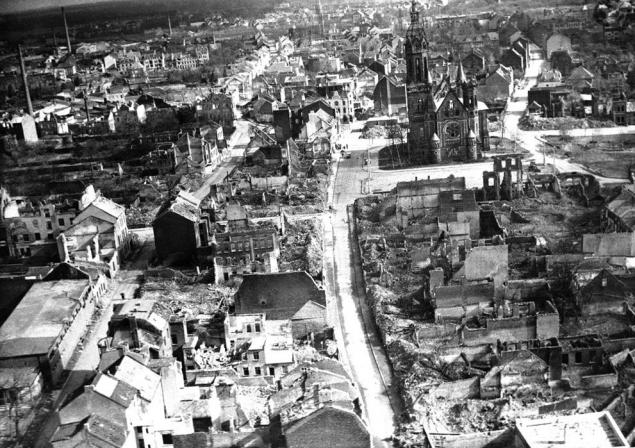
24. May 21, Colonel Byrd, Belsen camp commander, ordered the burning of the last hut Belsen concentration camp. Shots were fired into the sky in memory of the dead. At that moment, when he was set on fire last hut over the camp raised the British flag. German flag and a portrait of Hitler were burned together with Barak in June 1945. (AP Photo / British Official Photo) #.

25. The German mothers get their children in the first school opened after the war, the US military government, through the streets of Aachen, Germany, June 6, 1945. (AP Photo / Peter J. Carroll) #.
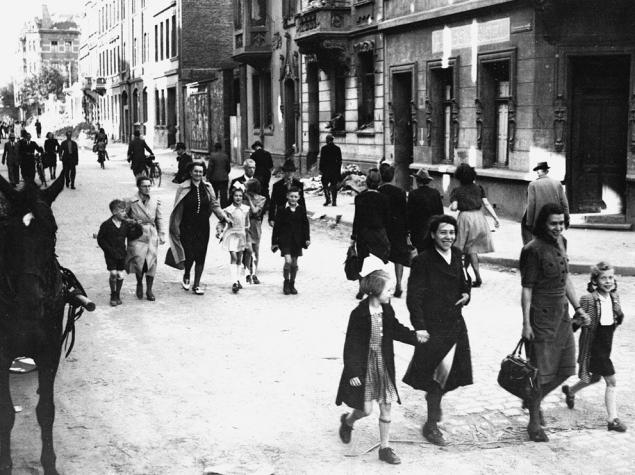
26. Meeting of the International Military Tribunal in Tokyo in April 1947. May 3, 1946, the Allies began the trial of 28 Japanese civilian and military leaders on charges of war crimes. Seven of them were executed by hanging, and the rest were sentenced to prison. (AP Photo) #.
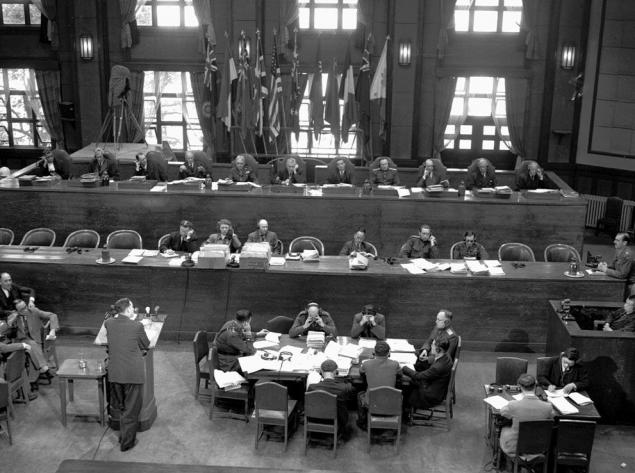
27. The Soviet soldiers are marching through the territory of North Korea, in October 1945. Japan 35 years occupied the Korean peninsula until the end of World War II. After the war, the Allied leaders decided to temporarily occupy the country before the elections and the establishment of the government. The Soviet Union occupied the northern part of the peninsula, and the US - South. Planned elections did not take place, as the USSR did North Korea communist country and the United States are based on the south of the peninsula's pro-Western government. Both countries claim the entire territory of the peninsula, which led to the Korean War, which began in 1950. In 1953, North and South Korea signed a truce, but formally they are still in a state of war. (Waralbum.ru) #.

28. The communist leader Kim Il Sung talking with a farmer from the county Qingshanli Kangso South Pyongan Province, North Korea, in October 1945. (Korean Central News Agency / Korea News Service via AP Images) #.
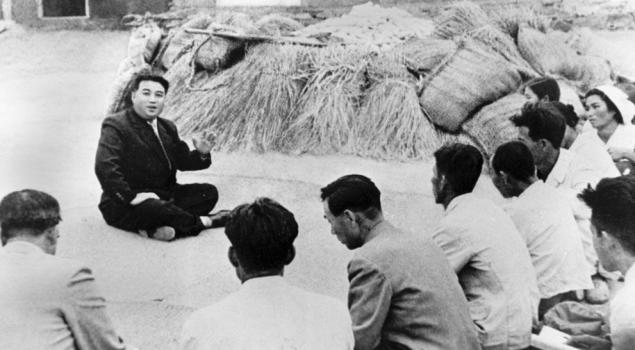
29. Soldiers of the Chinese Communist 8th Route Army are on parade ground in Yanan, urban district in the north of China, which was under the control of the Communist Party of China. These soldiers served in the battalion «Night Tiger». Communist Party of China fought a war for control of the state with the ruling Chinese Nationalist Party in 1927. Japanese invasion during the Second World War forced both sides to forget about their feuds together to defeat a common external enemy, but from time to time between the two is still clashes. At the end of the Second World War and the exit of Soviet troops from Manchuria in June 1946. China's civil war broke out. As a result, the CNR was defeated, and in 1949 and leader of the Communist Party of China, Mao Zedong founded the People's Republic of China. (AP Photo) #.

30. ENIAC (Electronic Numerical Integrator and Calculator), the first large-scale electronic computer, which was a unit weight of 30 tons and was located in the building of the University of Pennsylvania. ENIAC, which secretly developed at the Laboratory of ballistic studies in 1943, was designed to calculate firing tables. The computer was unveiled Feb. 14, 1946. Its inventors have promoted the use of new technologies and in 1946 at the University of Pennsylvania have read a series of lectures on the development of electronic digital computers. (AP Photo) #.
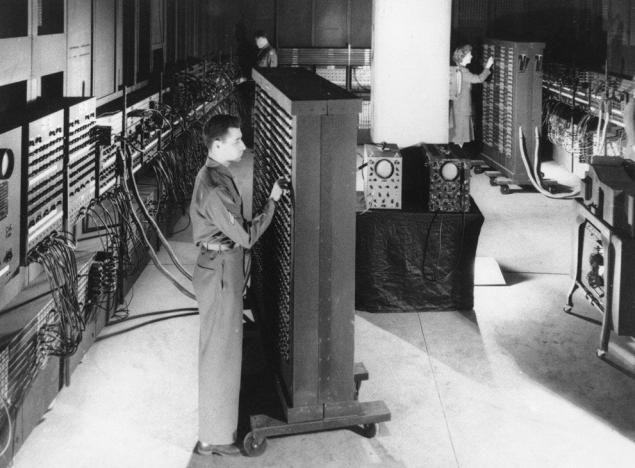
31. The nuclear test explosions, codenamed "Baker", which was part of "Operation Crossroads" at Bikini Atoll, Marshall Islands, 25 July 1946. The atomic bomb capacity of 40 kilotons was detonated under water at a depth of 27 m and at a distance of 5, 6 km from the atoll. The aim of the study was to investigate the effects of nuclear explosions on marine vessels. (NARA) #.
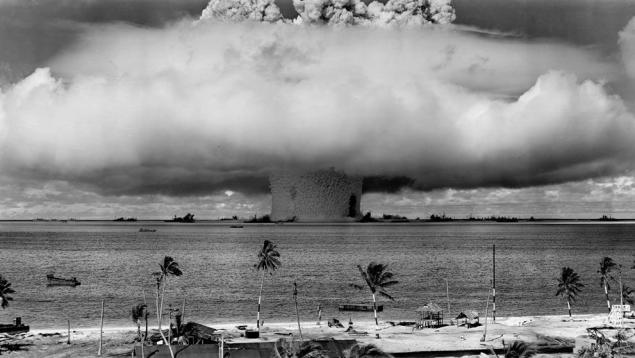
32. "Flying Wing» XB-35 aircraft company «Northrop» in the air in 1946. Experimental heavy bomber XB-35 was developed for the US Army during World War II. However, after the war, the army abandoned the project due to technical difficulties. (AP Photo) #.
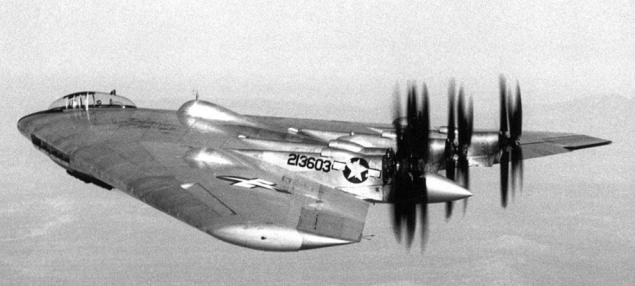
33. The soldiers thrown into the sea, Japanese ammunition, September 21, 1945. During the American occupation were destroyed almost all the products of the Japanese military industry. (U.S. Army) #.
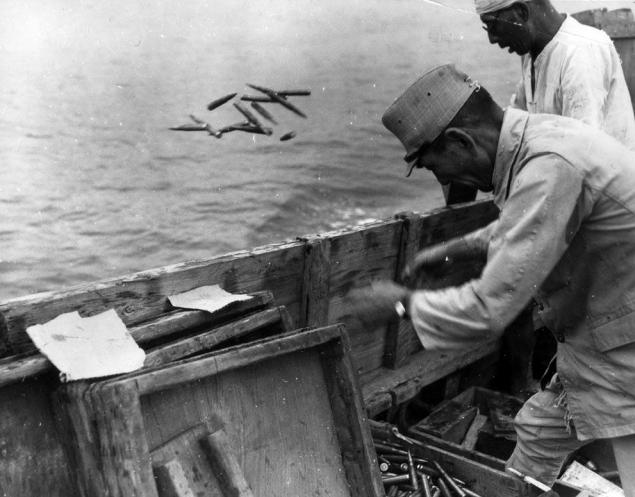
34. The German workers in protective clothing utilize toxic bomb on a US Army base in St. Georgen, Germany, June 28, 1946. Destruction of 65,000 tons of German toxic substances, including mustard gas, was carried out in two ways: burning or burial of shells and bombs in the North Sea. (AP Photo) #.

35. The US military authorities are preparing to execute by hanging 74-year-old Dr. Klaus Karl Schilling in Landsberg, Germany, May 28, 1946. He was sentenced to death on charges of conducting medical experiments on prisoners in 1200 Dachau. Thirty people died immediately after the injection of malaria and 300 to 400 experimental subsequently died from complications of the disease. He began to conduct his experiments in 1942. (AP Photo / Robert Clover) #.

36. The new cemetery at Belsen, Germany, where after the liberation of the concentration camp Bergen-Belsen were buried 13 thousand people, 28 March 1946. (AP Photo) #.
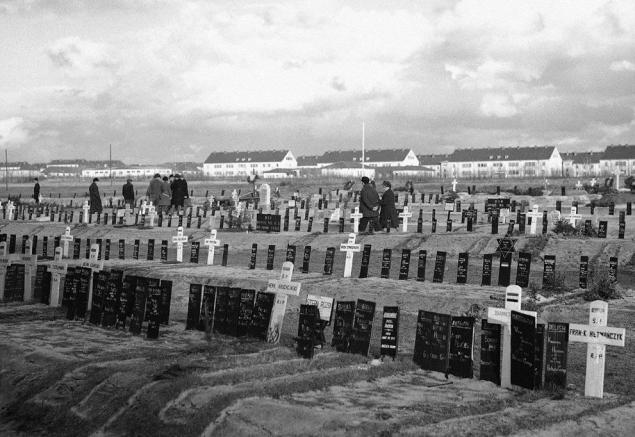
37. The Jews who escaped from a Nazi concentration camp Buchenwald, stand on the deck of an immigrant ship «Mataroa» in the port of Haifa during the British Mandate of Palestine, which was later transformed into the State of Israel, July 15, 1945. During World War II, millions of Jews fled from Germany and Nazi-occupied territories. Many of them tried to get into the British Mandate in Palestine, despite the severe restrictions on the entry of immigrants entered the United Kingdom in 1939. Many potential immigrants were rounded up and sent to internment camps. In 1947, Britain announced its decision to terminate the British Mandate, and the UN has adopted a plan for the partition of Palestine, founded the Israeli and Palestinian states. May 14, 1948, Israel declared itself an independent country, and he was immediately attacked by the neighboring Arab states. Thus began the Arab-Israeli conflict, which continues to this day. (Zoltan Kluger / GPO via Getty Images) #.

38. Polish orphans of war, who are in the care of the Polish Red Cross, the crowd in a Catholic orphanage in Lublin, September 11, 1946. Most of the clothes, as well as vitamins and medical supplies were provided by the American Red Cross shelter. (AP Photo) #.
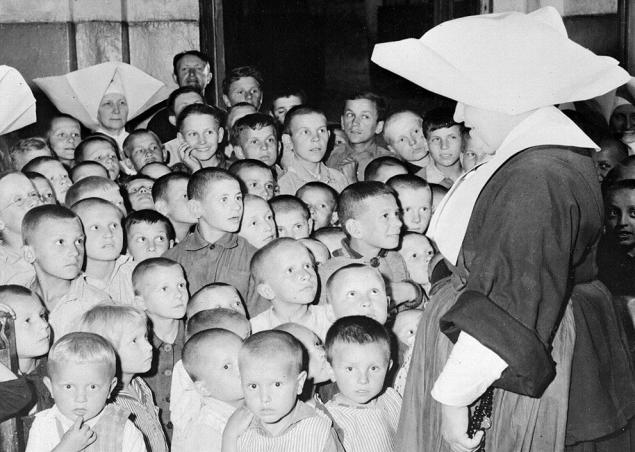
39. Empress of Japan attends a Catholic orphanage for children who lost their parents during the fighting and air raids on Tokyo. Empress toured the orphanage and visited the chapel. Children waving Japanese flags to greet the empress during her visit in Fujisawa, Tokyo, April 13, 1946. (AP Photo) #.
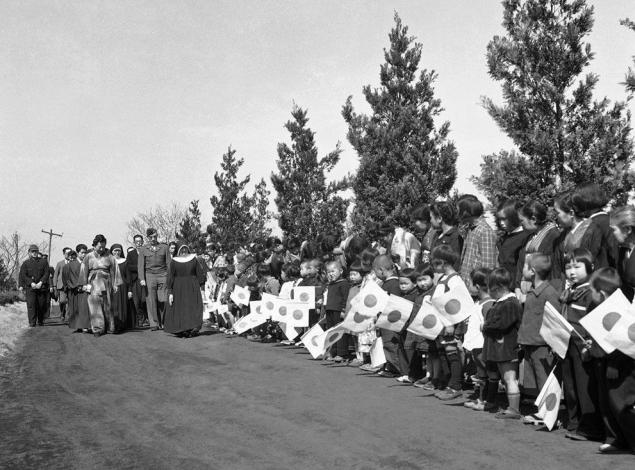
40. New construction (right) in the devastated area of Hiroshima, Japan, March 11, 1946. These single-storey houses were built along the highway in the program of the Japanese government to offset the affected areas of the country. In the background one can see on the left the damaged buildings to survive the explosion of the first atomic bomb. (AP Photo / Charles P. Gorry) #.
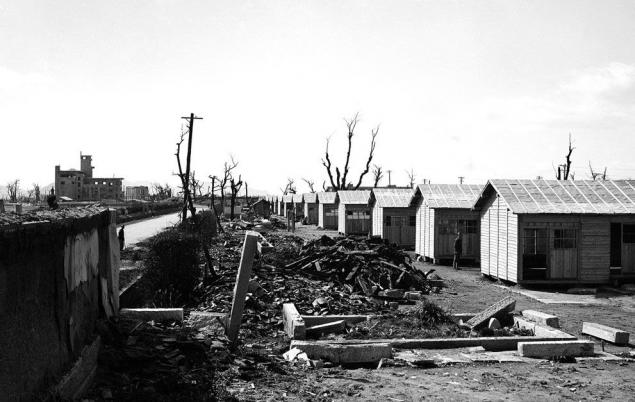
41. Manufacture of watches exported to allied countries. In April 1946, 34 Japanese factories produced 123,000 hours. This photo was taken June 25, 1946. (AP Photo / Charles Gorry) #.

42. Thousands of people greeted the American General George S. Patton during a parade in downtown Los Angeles, California, June 9, 1945. Shortly thereafter, Patton returned to Germany and died in a car accident in December 1945. (AP Photo) #.
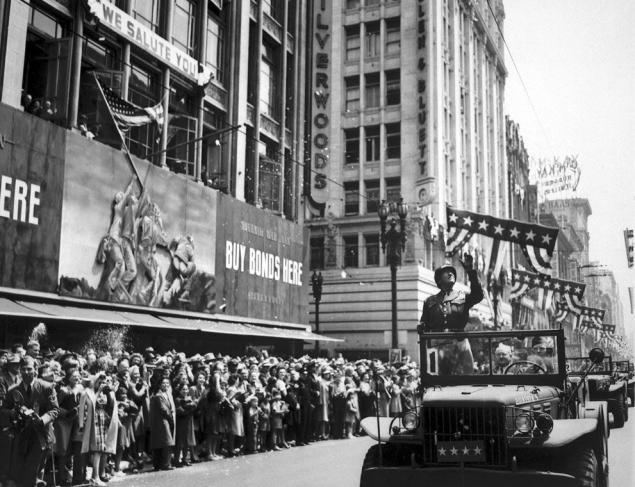
43. Residents of Germany removed debris in the street Tauentzienstrasse in Berlin near the Kaiser Wilhelm Memorial Church. Due to the lack of able-bodied men responsible for cleaning the ruins fell on the shoulders of women. Signs on the left indicate the border between British and American sector of occupation of Berlin. (AP Photo) #.
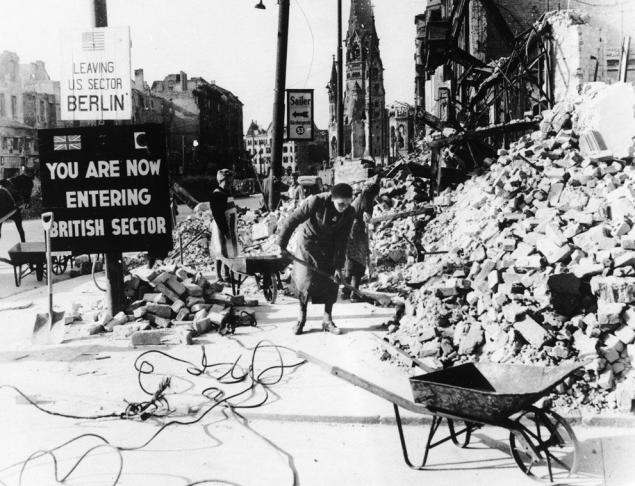
44. A mass rally at the Republic Square in front of the ruined Berlin Reichstag, September 9, 1948. About a quarter of a million anti-communists, gathered in the square to express their dissatisfaction with the Communist regime. (AP-Photo) #.

45. Hiroo Onoda, a former Japanese intelligence coming out of the jungle on the island of Lubango, the Philippines, where he was finally released from military service in March 1974, 29 years after the official end of World War II. He surrendered his sword (belt), a rifle, ammunition and hand grenades. Onoda was sent to the island of Lubango in December 1944, together with other soldiers prevent any attack of the enemy. A few months later allied troops occupied the island and killed or captured all but Onoda and three other Japanese soldiers. (AP Photo)

Occupation by Allied troops and some UN decisions have led to certain consequences in the future, including the division of Germany into East and West, as well as the formation of North and South Korea and the beginning of the Korean War in 1950. Thanks to the United Nations Partition Plan for Palestine in 1948, Israel declared itself an independent state, but broke the Arab-Israeli conflict. All ongoing tensions between the West and the Soviet bloc resulted in a "cold war". In connection with the development and proliferation of nuclear weapons in grave danger of World War III if the parties are unable to find a common language.
World War II was the most significant event of the 20th century, and its effects continue to influence the modern world, even after 65 years.
1. General Wehrmacht Anton Dostler tied to a pole before his execution by firing squad in Aversa, Italy, December 1, 1945. The general who commanded the 75th Army Corps, was sentenced to death by a military commission USA in Rome for the shooting of 15 unarmed American prisoners of war in La Spezia, Italy, March 26, 1944. (AP Photo) #.

2. The Soviet soldiers are with lowered Nazi flags during a parade in honor of Victory Day on Red Square in Moscow, June 24, 1945. (Yevgeny Khaldei / Waralbum.ru) #.

3. Exhausted Allied POWs collect things after liberation from Japanese captivity near Yokohama, Japan, September 11, 1945. (AP Photo) #.

4. Return of Soviet soldiers winners at the railway station in Moscow, 1945. (Arkady Shaikhet / Waralbum.ru) #.

5. Aerial view of Hiroshima, Japan, a year after the explosion of the atomic bomb, July 20, 1946. The city is slowly recovering due to lack of materials and equipment. (AP Photo / Charles P. Gorry) #.

6. Japanese sits near the charred ruins on the spot where once stood his home in Yokohama, Japan. (NARA) #.

7. Red Army Photographer Eugene Chaldea (center) in Berlin with Soviet troops near the Brandenburg Gate, in May 1945. (Waralbum.ru) #.

8. The fighter-bomber Ripablik P-47 "Thunderbolt" 12th Air Army US flies at low altitude over the refuge of Hitler in Berchtesgaden, Austria, May 26, 1945. On the ground around the damaged structure can be seen large and small craters from shells. (AP Photo) #.

9. Hermann Goering, the former commander of the Luftwaffe and the chairman of the Reichstag. The photograph was taken by the Office Central Registry of War Criminals and Security Suspects in Paris, France, November 5, 1945. May 9, 1945, Goering surrendered to US soldiers in Bavaria and was sent to Nuremberg, where stand trial on charges of war crimes. (AP Photo) #.

10. The interior of the courtroom, where in 1946 the Nuremberg Trials held hearings on the case of serious war crimes over 24 heads of government and civic leaders of Nazi Germany. Hermann Goering, the former commander of the Luftwaffe, sitting on a bench to testify (center right) in a gray jacket, wearing headphones and sunglasses. Next to him sat Rudolf Hess, the former Deputy Fuhrer of the party, Joachim von Ribbentrop, the former Foreign Minister of Nazi Germany, Wilhelm Keitel, former Chief of Staff of the Supreme Command of the armed forces of Germany and the SS-Obergruppenführer Ernst Kaltenbrunner. Goering, Ribbentrop, Keitel and Kaltenbrunner were sentenced to death by firing squad. Goering committed suicide the night before the execution. Hess was sentenced to life imprisonment, which is served in Spandau Prison in Berlin until his death in 1987. (AP Photo / STF) #.

11. Many of the captured German new and experimental aircraft were exhibited in London on the eve of Thanksgiving Day, September 14, 1945. Among the aircraft had been exhibited and jets. Photo: side view of a fighter Heinkel He-162 «Volksjager», which was equipped with a turbojet engine mounted above the fuselage, in Hyde Park in London. (AP Photo) #.

12. German POWs leveled the ground on the first American cemetery in the commune of Saint-Laurent-sur-Mer, France, close to the beach "Omaha", a year after the landing in Normandy, 28 May 1945. (AP Photo / Peter J. Carroll) #.

13. The Sudeten Germans go to the train station in the city of Liberec, the former Czechoslovakia to leave for Germany, July 1946. After the war, millions of German citizens and ethnic Germans were expelled from the territories annexed by Germany and the German states, which departed Poland and the Soviet Union. The number of deported Germans between 12 and 14 million. According to some estimates, during the resettlement died from 500,000 to 2 million Germans. (AP Photo / CTK) #.

14. Body Jinpe Teravama, surviving after the first in the history of the atomic bombing, scars after healing of burns, Hiroshima, June 1947. (AP Photo) #.

15. Broken buses made up for an acute shortage of housing in the capital of Japan, October 2, 1946. Homeless Japanese buses towed to a vacant lot and settle in their homes for their families. (AP Photo / Charles Gorry) #.

16. An American soldier hugs Japanese girl admiring Hibiya Park near the Imperial Palace Tokyo, January 21, 1946. (AP Photo / Charles Gorry) #.

17. Aerial view of the destroyed by bombing area of London near St Paul's Cathedral, in April 1945. (AP Photo) #.

18. General Charles de Gaulle (center) shakes hands with children in Lorient, France, two months after the surrender of Germany, in July 1945. During the Second World War in Lorient housed a German submarine base. Between 14 and 17 February 1943 at Lorient were dropped 500 high-explosive and over 60,000 incendiary bombs. The city was destroyed by 90%. (AFP / Getty Images) #.

19. The transport ship «General WP Richardson »with combatants on board is in the dock in New York, June 7, 1945. Many of these soldiers took part in the African campaign battles in Salerno, Anzio, Cassino and winter battles in the mountains of Italy. (AP Photo / Tony Camerano) #.

20. On the aerial photographs can be seen from the archive section Levitauna, New York, shortly after the completion of the post-war settlement on farmland in 1948. Levitaun was one of the first towns built for soldiers returning from World War II. He became a symbol of post-war suburban communities in the United States. (AP Photo / Levittown Public Library, File) #.

21. This TV, which costs $ 100, was the first receiver, retailing at an affordable price. Television was invented before the start of the Second World War, but military action prevented the mass production of televisions. (AP Photo / Ed Ford) #.

22. US soldier inspects a gold statuette of a personal cache of Hermann Goering found the 7th US Army in a cave near Schonau am Konigssee, Germany, May 25, 1945. In the secret cave also found stolen priceless paintings from all over Europe. (AP Photo / Jim Pringle) #.

23. Some churches in Europe have been razed to the ground, while others remained standing among the ruins. Photo: menhengladbahskoy Cathedral towers over the ruins, but it requires the restoration of the building, Germany, November 29, 1945. (AP Photo) #.

24. May 21, Colonel Byrd, Belsen camp commander, ordered the burning of the last hut Belsen concentration camp. Shots were fired into the sky in memory of the dead. At that moment, when he was set on fire last hut over the camp raised the British flag. German flag and a portrait of Hitler were burned together with Barak in June 1945. (AP Photo / British Official Photo) #.

25. The German mothers get their children in the first school opened after the war, the US military government, through the streets of Aachen, Germany, June 6, 1945. (AP Photo / Peter J. Carroll) #.

26. Meeting of the International Military Tribunal in Tokyo in April 1947. May 3, 1946, the Allies began the trial of 28 Japanese civilian and military leaders on charges of war crimes. Seven of them were executed by hanging, and the rest were sentenced to prison. (AP Photo) #.

27. The Soviet soldiers are marching through the territory of North Korea, in October 1945. Japan 35 years occupied the Korean peninsula until the end of World War II. After the war, the Allied leaders decided to temporarily occupy the country before the elections and the establishment of the government. The Soviet Union occupied the northern part of the peninsula, and the US - South. Planned elections did not take place, as the USSR did North Korea communist country and the United States are based on the south of the peninsula's pro-Western government. Both countries claim the entire territory of the peninsula, which led to the Korean War, which began in 1950. In 1953, North and South Korea signed a truce, but formally they are still in a state of war. (Waralbum.ru) #.

28. The communist leader Kim Il Sung talking with a farmer from the county Qingshanli Kangso South Pyongan Province, North Korea, in October 1945. (Korean Central News Agency / Korea News Service via AP Images) #.

29. Soldiers of the Chinese Communist 8th Route Army are on parade ground in Yanan, urban district in the north of China, which was under the control of the Communist Party of China. These soldiers served in the battalion «Night Tiger». Communist Party of China fought a war for control of the state with the ruling Chinese Nationalist Party in 1927. Japanese invasion during the Second World War forced both sides to forget about their feuds together to defeat a common external enemy, but from time to time between the two is still clashes. At the end of the Second World War and the exit of Soviet troops from Manchuria in June 1946. China's civil war broke out. As a result, the CNR was defeated, and in 1949 and leader of the Communist Party of China, Mao Zedong founded the People's Republic of China. (AP Photo) #.

30. ENIAC (Electronic Numerical Integrator and Calculator), the first large-scale electronic computer, which was a unit weight of 30 tons and was located in the building of the University of Pennsylvania. ENIAC, which secretly developed at the Laboratory of ballistic studies in 1943, was designed to calculate firing tables. The computer was unveiled Feb. 14, 1946. Its inventors have promoted the use of new technologies and in 1946 at the University of Pennsylvania have read a series of lectures on the development of electronic digital computers. (AP Photo) #.

31. The nuclear test explosions, codenamed "Baker", which was part of "Operation Crossroads" at Bikini Atoll, Marshall Islands, 25 July 1946. The atomic bomb capacity of 40 kilotons was detonated under water at a depth of 27 m and at a distance of 5, 6 km from the atoll. The aim of the study was to investigate the effects of nuclear explosions on marine vessels. (NARA) #.

32. "Flying Wing» XB-35 aircraft company «Northrop» in the air in 1946. Experimental heavy bomber XB-35 was developed for the US Army during World War II. However, after the war, the army abandoned the project due to technical difficulties. (AP Photo) #.

33. The soldiers thrown into the sea, Japanese ammunition, September 21, 1945. During the American occupation were destroyed almost all the products of the Japanese military industry. (U.S. Army) #.

34. The German workers in protective clothing utilize toxic bomb on a US Army base in St. Georgen, Germany, June 28, 1946. Destruction of 65,000 tons of German toxic substances, including mustard gas, was carried out in two ways: burning or burial of shells and bombs in the North Sea. (AP Photo) #.

35. The US military authorities are preparing to execute by hanging 74-year-old Dr. Klaus Karl Schilling in Landsberg, Germany, May 28, 1946. He was sentenced to death on charges of conducting medical experiments on prisoners in 1200 Dachau. Thirty people died immediately after the injection of malaria and 300 to 400 experimental subsequently died from complications of the disease. He began to conduct his experiments in 1942. (AP Photo / Robert Clover) #.

36. The new cemetery at Belsen, Germany, where after the liberation of the concentration camp Bergen-Belsen were buried 13 thousand people, 28 March 1946. (AP Photo) #.

37. The Jews who escaped from a Nazi concentration camp Buchenwald, stand on the deck of an immigrant ship «Mataroa» in the port of Haifa during the British Mandate of Palestine, which was later transformed into the State of Israel, July 15, 1945. During World War II, millions of Jews fled from Germany and Nazi-occupied territories. Many of them tried to get into the British Mandate in Palestine, despite the severe restrictions on the entry of immigrants entered the United Kingdom in 1939. Many potential immigrants were rounded up and sent to internment camps. In 1947, Britain announced its decision to terminate the British Mandate, and the UN has adopted a plan for the partition of Palestine, founded the Israeli and Palestinian states. May 14, 1948, Israel declared itself an independent country, and he was immediately attacked by the neighboring Arab states. Thus began the Arab-Israeli conflict, which continues to this day. (Zoltan Kluger / GPO via Getty Images) #.

38. Polish orphans of war, who are in the care of the Polish Red Cross, the crowd in a Catholic orphanage in Lublin, September 11, 1946. Most of the clothes, as well as vitamins and medical supplies were provided by the American Red Cross shelter. (AP Photo) #.

39. Empress of Japan attends a Catholic orphanage for children who lost their parents during the fighting and air raids on Tokyo. Empress toured the orphanage and visited the chapel. Children waving Japanese flags to greet the empress during her visit in Fujisawa, Tokyo, April 13, 1946. (AP Photo) #.

40. New construction (right) in the devastated area of Hiroshima, Japan, March 11, 1946. These single-storey houses were built along the highway in the program of the Japanese government to offset the affected areas of the country. In the background one can see on the left the damaged buildings to survive the explosion of the first atomic bomb. (AP Photo / Charles P. Gorry) #.

41. Manufacture of watches exported to allied countries. In April 1946, 34 Japanese factories produced 123,000 hours. This photo was taken June 25, 1946. (AP Photo / Charles Gorry) #.

42. Thousands of people greeted the American General George S. Patton during a parade in downtown Los Angeles, California, June 9, 1945. Shortly thereafter, Patton returned to Germany and died in a car accident in December 1945. (AP Photo) #.

43. Residents of Germany removed debris in the street Tauentzienstrasse in Berlin near the Kaiser Wilhelm Memorial Church. Due to the lack of able-bodied men responsible for cleaning the ruins fell on the shoulders of women. Signs on the left indicate the border between British and American sector of occupation of Berlin. (AP Photo) #.

44. A mass rally at the Republic Square in front of the ruined Berlin Reichstag, September 9, 1948. About a quarter of a million anti-communists, gathered in the square to express their dissatisfaction with the Communist regime. (AP-Photo) #.

45. Hiroo Onoda, a former Japanese intelligence coming out of the jungle on the island of Lubango, the Philippines, where he was finally released from military service in March 1974, 29 years after the official end of World War II. He surrendered his sword (belt), a rifle, ammunition and hand grenades. Onoda was sent to the island of Lubango in December 1944, together with other soldiers prevent any attack of the enemy. A few months later allied troops occupied the island and killed or captured all but Onoda and three other Japanese soldiers. (AP Photo)





